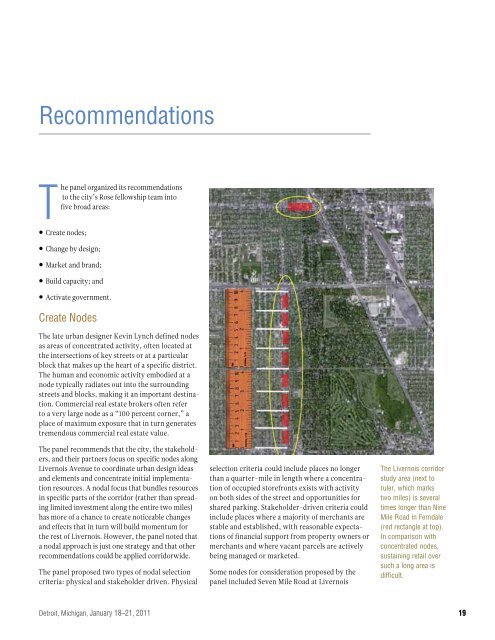Detroit Michigan
Detroit Michigan
Detroit Michigan
You also want an ePaper? Increase the reach of your titles
YUMPU automatically turns print PDFs into web optimized ePapers that Google loves.
Recommendations<br />
The panel organized its recommendations<br />
to the city’s Rose fellowship team into<br />
five broad areas:<br />
Create nodes;<br />
Change by design;<br />
Market and brand;<br />
Build capacity; and<br />
Activate government.<br />
Create Nodes<br />
The late urban designer Kevin Lynch defined nodes<br />
as areas of concentrated activity, often located at<br />
the intersections of key streets or at a particular<br />
block that makes up the heart of a specific district.<br />
The human and economic activity embodied at a<br />
node typically radiates out into the surrounding<br />
streets and blocks, making it an important destination.<br />
Commercial real estate brokers often refer<br />
to a very large node as a “100 percent corner,” a<br />
place of maximum exposure that in turn generates<br />
tremendous commercial real estate value.<br />
The panel recommends that the city, the stakeholders,<br />
and their partners focus on specific nodes along<br />
Livernois Avenue to coordinate urban design ideas<br />
and elements and concentrate initial implementation<br />
resources. A nodal focus that bundles resources<br />
in specific parts of the corridor (rather than spreading<br />
limited investment along the entire two miles)<br />
has more of a chance to create noticeable changes<br />
and effects that in turn will build momentum for<br />
the rest of Livernois. However, the panel noted that<br />
a nodal approach is just one strategy and that other<br />
recommendations could be applied corridorwide.<br />
The panel proposed two types of nodal selection<br />
criteria: physical and stakeholder driven. Physical<br />
<strong>Detroit</strong>, <strong>Michigan</strong>, January 18–21, 2011<br />
selection criteria could include places no longer<br />
than a quarter-mile in length where a concentration<br />
of occupied storefronts exists with activity<br />
on both sides of the street and opportunities for<br />
shared parking. Stakeholder-driven criteria could<br />
include places where a majority of merchants are<br />
stable and established, with reasonable expectations<br />
of financial support from property owners or<br />
merchants and where vacant parcels are actively<br />
being managed or marketed.<br />
Some nodes for consideration proposed by the<br />
panel included Seven Mile Road at Livernois<br />
The Livernois corridor<br />
study area (next to<br />
ruler, which marks<br />
two miles) is several<br />
times longer than Nine<br />
Mile Road in Ferndale<br />
(red rectangle at top).<br />
In comparison with<br />
concentrated nodes,<br />
sustaining retail over<br />
such a long area is<br />
difficult.<br />
19


